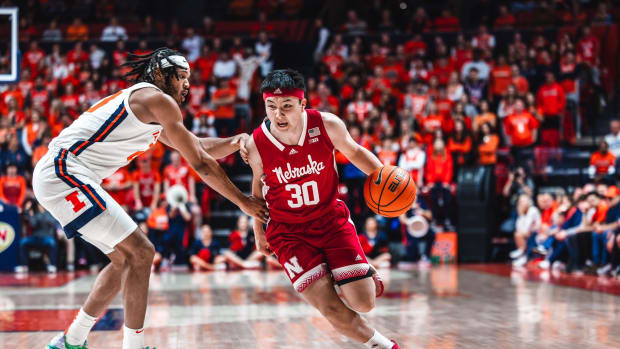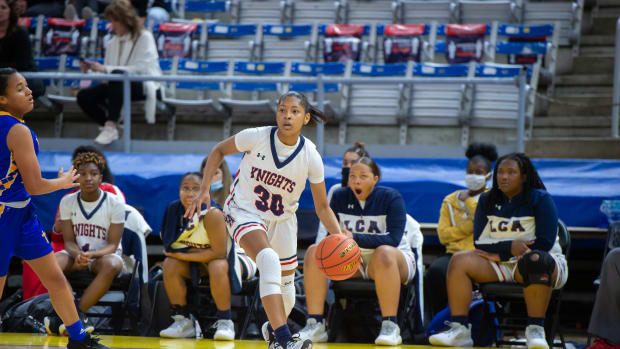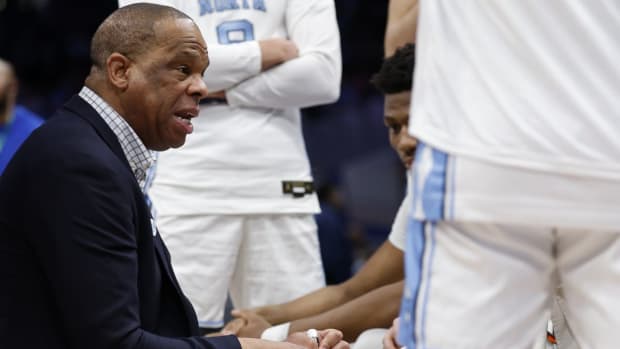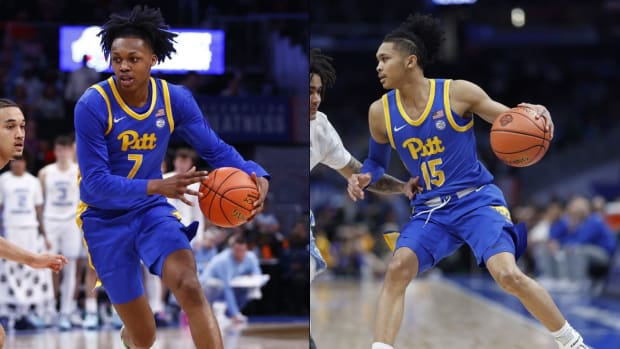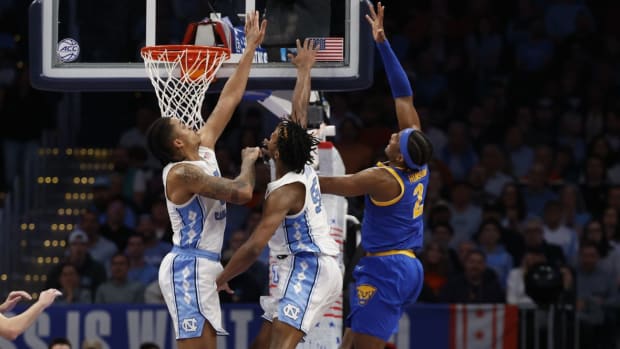How college teams will replace NBA draft lottery picks
For many college basketball fans, the NBA draft triggers a mixed emotional response. On the one hand, you’re probably happy to see the stars from your favorite program picked. On the other hand, you’re likely disappointed because those same players won’t be around to help next season. The latter feeling can be mitigated to some extent by solid replacement plans. Your favorite team may be losing a stud, but maybe it has recruited another one to fill his spot. Below is a look at how each program that lost a lottery pick can overcome that player’s departure.
LSU
Player drafted/class: Ben Simmons/freshman
Pick/team: No. 1/Philadelphia 76ers
The Tigers will begin this season facing much lower expectations than they carried into last season. Without Simmons, expect LSU to build around the other five-star prospect in his recruiting class, shooting guard Antonio Blakeney; a four-star prospect in that recruiting class, shooting guard Brandon Sampson; and big man Craig Victor II, who became eligible last December after transferring from Arizona. This team probably won’t be as good as it was in 2015–16, but defensive improvement (147th in adjusted points allowed per possession) plus a leap from Blakeney is a sound blueprint for moderate success. And since LSU did not qualify for the NCAA tournament with Simmons, the bar to clear is low.
Duke
Player drafted/class: Brandon Ingram/freshman
Pick/team: No. 2/Los Angeles Lakers
The Blue Devils will miss Ingram’s scoring and positional versatility, but they might be the best team in the country anyway. Duke brings back an efficient, high-usage offensive cog (Grayson Allen), a potent perimeter scoring threat (Luke Kennard), a capable three-point shooter who could thrive in a reserve role (Matt Jones) and a veteran big man with defensive versatility and a strong track record as a rebounder who appeared in only nine games last season because of a foot injury (Amile Jefferson). And that’s just who Duke returns: Mike Krzyzewski and his staff also compiled the nation’s top recruiting class, according to Scout.com, a six-man group led by power forward Harry Giles, small forward Jayson Tatum, point guard Frank Jackson and center Marques Bolden.
California
Player drafted/class: Jaylen Brown/freshman
Pick/team: No. 3/Boston Celtics
Cal’s 2016–17 outlook would have been far more dire had it also lost the other five-star prospect in its 2015 recruiting class, Ivan Rabb, to the NBA. Alas, Rabb decided to return to Berkeley for another season even though he was projected as a lottery pick, giving the Bears an all-conference-caliber player around which to build. And Cal also has seven-footers Kameron Rooks and Kingsley Okoroh, plus veteran point guard Sam Singer, returning. Unfortunately for the Bears, Brown wasn’t their only key player to leave the program this off-season. Top scorer Tyrone Wallace, who was selected with the final pick in the draft by the Utah Jazz, is out of eligibility and starting guard Jordan Mathews elected to transfer. That leaves Cal without three of its four highest-usage offensive players, its best three-point shooter (Mathews) and facilitator (Wallace).
• Why Ivan Rabb set aside the NBA for another year at Cal
Providence
Player drafted/class: Kris Dunn/junior
Pick/team: No. 5/Minnesota Timberwolves
There is no one player on Providence’s roster who can replace Dunn. The Friars will need contributions from a variety of sources to recreate his production. Rising junior Kyron Cartwright should step in at point guard, and four-star prospect Maliek White can add depth to Providence’s perimeter rotation. Still, the Friars will need scoring from their frontcourt—namely forwards Rodney Bullock and Jalen Lindsey—to offset the impact of the loss of another conference first team player (Ben Bentil). In a Big East with a national championship contender (Villanova), a legitimate conference title threat (Xavier) and another potential top-25 team (Creighton), Providence is a cut below the top tier. After consecutive seasons of NCAA tournament appearances and top-50 kenpom.com rankings, look for the Friars to fall off a bit in 2016–17.
Oklahoma
Player drafted/class: Buddy Hield/senior
Pick/team: No. 6/New Orleans Pelicans
Arguably no one on this list will be harder to replace than Hield, who was named the Naismith player of the year in 2016 after leading the Big 12 in points per game, offensive Box Plus/Minus and Player Efficiency Rating. Senior Jordan Woodard can help fill the scoring void by replicating the 45.5% mark he notched on three-point tries last season, rising sophomore Christian James could supplement Woodard’s shooting after logging only 9.7 minutes per game in 2015–16 (he shot 50% from deep, but on only 34 attempts) and Oklahoma brings in top-40 recruit Kameron McGusty. Yet the Sooners aren’t just waving farewell to the best player in college basketball; starting guard Isaiah Cousins, selected with the No. 59 pick by the Sacramento Kings, and big man Ryan Spangler are also leaving. This is no minor re-tooling for coach Lon Kruger; Oklahoma is entering what looks like a textbook transition season.
Kentucky
Player drafted/class: Jamal Murray/freshman
Pick/team: No. 7/Denver Nuggets
This isn’t so bad compared to the four players coach John Calipari watched get selected in the lottery last year (Karl-Anthony Towns, Willie Cauley-Stein, Trey Lyles and Devin Booker). Setting Murray aside for a moment, Kentucky probably won’t have a hard time filling the 15.8 minutes per game center Skal Labissiere—who fell out of the lottery, to pick No. 28 with the Sacramento Kings, on Thursday night—logged last season; it returns big men Isaac Humphries, Tai Wynyard and Derek Willis and welcomes in three top-30 forwards in Edrice “Bam” Adebayo, Wenyen Gabriel and Sacha Killeya-Jones. The loss of Murray will hurt quite a bit, though, given he was one of the best perimeter scorers in the country last season, with a per-40 minute average of 22.7 points and a 40.1 three-point percentage on 7.7 attempts per game. But with five-star guards De’Aaron Fox and Malik Monk on the way, and Isaiah Briscoe eschewing the NBA for another season in Lexington, the Wildcats can feel comfortable about the state of their backcourt.
• How Jamal Murray's father helped him become a lottery pick
Washington
Player drafted/class: Marquese Chriss/freshman
Pick/team: No. 8/Sacramento Kings (traded to Phoenix Suns)
The Huskies are losing a player selected with the No. 8 pick in this year’s draft, but a recruit in their 2016 class, one far more highly regarded than Chriss at the outset of his college career, has the potential to be selected higher in next year’s draft. With guard Dejounte Murray joining Chriss as a first-round selection on Thursday (No. 29 to the San Antonio Spurs)—and senior Andrew Andrews, Washington’s leader in points and minutes per game in 2015–16, running out of eligibility—Markelle Fultz should shoulder a large usage and shot-creation load right away. While arguably no freshman is better equipped to make a big impact as a perimeter scorer and playmaker next season than the five-star point guard, the Huskies don’t have a transcendent talent like Fultz entering their frontcourt to replace Chriss. But Auburn transfer Matthew Atewe and four-star center Sam Timmins, of Dunedin, New Zealand, can buttress a rotation that returns rising sophomores Noah Dickerson and Devenir Duruisseau and senior Malik Dime.
Utah
Player drafted/class: Jakob Poeltl/sophomore
Pick/team: No. 9/Toronto Raptors
The last two seasons, Utah has suited up two first-team All-Americans who helped it notch at least 25 wins and make the NCAA tournament. Guard Delon Wright was selected late in the first round of last year’s draft, and Poeltl was picked in the lottery this year. Barring an unexpected leap from one of the players’ on the Utes’ current roster, they almost certainly won’t have a first-team All-America in 2017, and their tourney prospects feel less certain. However, coach Larry Krystkowiak will be able to fill the massive hole in his big man rotation with some intriguing pieces, including forward Kyle Kuzma, seven-footer Jayce Johnson, Utah State transfer David Collette (eligible in mid-December) and Salt Lake Community College transfer Tyler Rawson. The problem for Utah is that it also lost two other valuable frontcourt players this off-season: Brekkott Chapman (to transfer) and Jordan Loveridge (to graduation). That’s a lot of production leaving Salt Lake City; the Utes don’t look capable of hanging with Arizona and Oregon in the Pac-12 next season.
Gonzaga
Player drafted/class: Domantas Sabonis/sophomore
Pick/team: No. 11/Orlando Magic (traded to Oklahoma City Thunder)
Sabonis was one of the best rebounders, two-point scorers and foul-drawers in the West Coast Conference last season, and he helped push the Zags off the NCAA tournament bubble and into the field for the 17th consecutive year by registering 15 points and eight rebounds in their win over a good Saint Mary’s team in the conference title game. That streak should continue despite Sabonis’s departure. Coach Mark Few’s team might actually take a modest leap next season despite losing Sabonis and fellow first-team All-WCC member Kyle Wiltjer (who went undrafted but agreed to a deal with the Houston Rockets). Coveted Missouri transfer Johnathan Williams III will be eligible to prop up a frontcourt that will also feature center/human mountain Przemek Karnowski, who played in only five games last season because of a back injury but is a force on both ends when healthy. The Zags also bring in one of the nation’s top center recruits, Bishop Gorman (Nev.) High’s Zach Collins, four-star power forward Killian Tillie, a native of France, and two talented guard transfers: Nigel Williams-Goss (Washington) and Jordan Mathews (Cal).
• Inside Shaka Smart's new recruiting strategy at Texas
Baylor
Player drafted/class: Taurean Prince/senior
Pick/team: No. 12/Utah Jazz (traded to Atlanta Hawks)
The moment from Prince’s final season in Waco that will endure in the college hoops consciousness the longest is the hilarious response he gave at a press conference following Baylor’s upset loss to Yale in the NCAA tournament. But that shouldn’t obscure the value Prince provided in 2015–16 as a scorer, rebounder and perimeter defender, and how challenging it will be for coach Scott Drew to reconfigure the team’s rotation without him, rebounding machine Rico Gathers and point guard Lester Medford. To avoid major slippage, Baylor will need to hope 6'9" rising junior Johnathan Motley can excel in a larger role, and that incoming junior college transfer Nuni Omot, four-star signee Mark Vital, returning forward Terry Maston and seven-footer Jo Acuil can provide some help in the frontcourt. The Bears’ perimeter group should be in decent shape, with guards King McClure, Al Freeman and Ish Wainwright all back and Miami transfer Manu Lecomte, a proficient three-point shooter, entering the fold.
Michigan State
Player drafted/class: Denzel Valentine/senior
Pick/team: No. 14/Chicago Bulls
Valentine was the main reason Hield didn’t run away with the Naismith award last season. A potent long-range marksman and skilled playmaker, Valentine drove Michigan State to the No. 3 spot in kenpom.com’s adjusted offensive efficiency rankings and finished fourth—one spot behind Hield—in his player of the year rankings. The bad news: the Spartans probably won’t have anyone as good as Valentine on their team next season, and they also lose big men Matt Costello and Deyonta Davis (drafted 31st overall by the Boston Celtics, then traded to the Memphis Grizzlies) and an even more accurate three-point shooter than Valentine in guard Bryn Forbes. The good news: Michigan State is primed to make another run at a top-two tourney seed. Guards Eron Harris, Lourawls “Tum Tum” Nairn and Matt McQuaid are all back, UNLV import Ben Carter is eligible immediately as a graduate transfer and the Spartans signed the nation’s No. 5 recruiting class, according to Scout.com—led by five-star forward Miles Bridges and five-star shooting guard Josh Langford. Losing Valentine and Davis will hurt, but Michigan State can move forward confident it won’t experience a significant downturn in 2016–17.
Bonus: The first two college players taken outside of the lottery
Vanderbilt
Player drafted/class: Wade Baldwin IV/sophomore
Pick/team: No. 17/Memphis Grizzlies
If LSU wasn’t the nation’s most disappointing team this season, then perhaps Vanderbilt deserves that distinction. One of the main reasons they were a trendy pick to push Kentucky in the SEC was Baldwin, a skilled sophomore point guard who fueled lofty preseason projections by assisting on 31% of his team’s baskets and sinking 44% of his three-point attempts in 2014–15. And he was pretty good last season, too, with a considerably bigger usage load, posting a higher Player Efficiency Rating and earning a spot on the All-SEC second team. Now that Baldwin is gone, Vanderbilt will hope that rising junior Riley LaChance regains the form that made him one of the Commodores’ top perimeter threats as a freshman and that fellow rising junior Matthew Fisher-Davis will spend another season knocking down 45% of his treys. The Tennessean reported in May that rising junior forward Jeff Roberson could see time at point guard, and the Commodores bring in a three-star prospect at the position in Payton Willis. Vanderbilt also is losing junior center Damian Jones to the NBA, but new coach Bryce Drew has more than enough talent around to keep his team in the upper half of the SEC.
• Why are top recruits forgoing traditional high schools & joining superteams?
Marquette
Player drafted/class: Henry Ellenson/freshman
Pick/team: No. 18/Detroit Pistons
Accounting for the departure of a top-10 prospect is more difficult for a program that can’t simply replace him with another one: Marquette doesn’t have a five-star power forward to plug in for Ellenson. Yet while the Golden Eagles’ incoming recruiting class doesn’t compare favorably to Duke’s or Kentucky’s, they do have a decent amount of talent returning from a team that increased its win total by seven in coach Steve Wojciechowski’s second season, and some more en route to Milwaukee via the recruiting trail and transfer market. Senior Luke Fischer and sophomore Matt Heldt are expected to anchor the frontcourt, and the Golden Eagles won’t lack for perimeter firepower. Between four-star small forward Sam Hauser, four-star point guard Markus Howard, UNC-Asheville transfer Andrew Rowsey, USC graduate transfer Katin Reinhardt and multiple returnees, Marquette should be able to spread the floor well while Fischer bangs inside.


